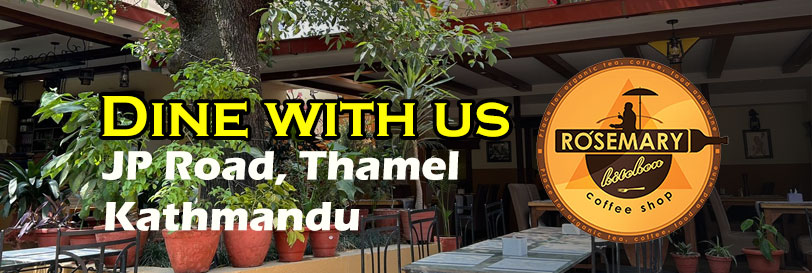Overview And Highlights
TRIP FACTS

The 19 Days Manaslu and Annapurna Circuit Trek is a once-in-a-lifetime Himalayan adventure combining two of Nepal’s most spectacular trekking routes into one epic journey. Starting from the lush river valleys of the Manaslu Circuit, you’ll venture through remote Gurung and Tibetan-influenced villages, cross the challenging Larke La Pass (5,106m), and merge into the famed Annapurna Circuit, culminating in the crossing of Thorong La Pass (5,416m) — one of the world’s highest trekking passes.
This combined trek delivers a rare blend of cultural immersion, diverse landscapes, and high-altitude challenges. From tropical river gorges and alpine meadows to glaciers and towering snow-capped peaks, the journey offers an ever-changing backdrop. You'll encounter the warm hospitality of Nepal’s ethnic communities, explore ancient monasteries, and walk in the shadows of Himalayan giants such as Manaslu (8,163m), Annapurna I (8,091m), and Dhaulagiri (8,167m).
The trail begins in Machha Khola and winds its way through the Budhi Gandaki Valley, gradually gaining altitude and providing ample acclimatization opportunities in villages like Samagaun and Manang. Along the way, trekkers can explore hidden gems such as Ice Lake, Birendra Lake, and several centuries-old Buddhist monasteries.
By combining the Manaslu and Annapurna Circuits, you avoid the more crowded sections of the latter while still experiencing its crown jewel — the Thorong La Pass — before descending to the sacred site of Muktinath. The trek concludes with a scenic drive through the Kali Gandaki Gorge, the world’s deepest canyon, to Pokhara, and finally back to Kathmandu.
Trip Highlights:
-
Trek two iconic Himalayan circuits in a single journey.
-
Cross two major high passes: Larke La (5,106m) & Thorong La (5,416m).
-
Breathtaking views of Manaslu, Annapurna, Dhaulagiri, Lamjung, Gangapurna, and more.
-
Rich cultural encounters with Gurung, Magar, Thakali, and Tibetan communities.
-
Visit Ice Lake, Birendra Lake, and centuries-old Buddhist monasteries.
-
Scenic drives through dramatic valleys and gorges.
-
Fewer crowds on Manaslu Circuit for a more authentic Himalayan experience.
Best Season for 19 Days Manaslu & Annapurna Circuit Trek
| Season | Months | Weather & Trail Conditions |
|---|---|---|
| Spring | March – May | Stable weather, rhododendrons in bloom, clear skies, best mountain views. |
| Autumn | September – November | Crisp air, excellent visibility, ideal for high passes. Peak trekking season. |
| Winter | December – February | Cold, especially at high passes, but fewer trekkers and stunning snow views. |
| Monsoon | June – August | Heavy rain, leeches, landslide risks; Manaslu section less favorable. Not recommended. |
What to Pack – Categorized
Clothing:
-
Moisture-wicking base layers (top & bottom)
-
Insulating mid-layers (fleece, down jacket)
-
Waterproof shell jacket & pants
-
Trekking trousers & shorts
-
Warm hat, sun hat, buff/scarf
-
Gloves (inner & insulated outer)
-
Warm socks (4–5 pairs), liner socks
Footwear:
-
Waterproof trekking boots (broken-in)
-
Lightweight camp shoes or sandals
-
Gaiters (for snow on passes)
Gear & Equipment:
-
Sleeping bag (–15°C comfort rating)
-
Trekking poles
-
Backpack (40–50L) + rain cover
-
Daypack (20–25L)
-
Headlamp + extra batteries
-
Sunglasses (UV protection)
Personal Items:
-
Reusable water bottles/hydration bladder
-
Water purification tablets/filter
-
Sunscreen (SPF 50+) & lip balm
-
Toiletries & quick-dry towel
-
Basic first aid kit & personal medication
Electronics:
-
Camera or smartphone + chargers
-
Power bank/solar charger
-
Adapter (Type C/D/M for Nepal)
Itinerary Expand All Close All
Your adventure begins with a scenic drive westward along the Prithvi Highway before turning north through the Gorkha district. The journey follows the winding Trishuli and Budhi Gandaki Rivers, passing terraced fields, small market towns, and lush green hills. We reach Machha Khola, a riverside village where the sound of flowing water sets the tone for the trek ahead.
Food
BLD
Accomodation
Teahouse
Elevation
900
The trek starts gently, crossing suspension bridges over the Budhi Gandaki and navigating through forested ridges. We pass small Gurung settlements and natural hot springs at Tatopani before climbing stone steps into the picturesque village of Jagat, known for its slate-paved streets and traditional houses.
Food
BLD
Accomodation
Teahouse
Elevation
1410
Leaving Jagat, the trail undulates through subtropical forests and cliffside paths. We pass the checkpoint for the Manaslu Conservation Area and follow the river upstream to Philim, a large Gurung village. Continuing through millet and buckwheat fields, we finally arrive at Deng, a small settlement with Tibetan cultural influences.
Food
BLD
Accomodation
Teahouse
Elevation
1800
Today’s walk takes us deeper into the Himalayan foothills. The scenery shifts to pine and rhododendron forests, with occasional glimpses of Manaslu’s snowy peaks. We cross several suspension bridges and ascend gradually to Namrung, a charming village with intricately carved wooden houses and prayer wheels. Namrung offers our first panoramic view of Manaslu, Ganesh Himal, and Himalchuli.
Food
BLD
Accomodation
Teahouse
Elevation
2630
A steady climb through alpine landscapes leads us past the villages of Lho and Shyala, each offering striking views of the mountains. Monasteries, chortens, and mani walls dot the trail. We eventually reach Samagaun, a traditional Tibetan-style village situated directly beneath Manaslu’s majestic north face.
Food
BLD
Accomodation
Teahouse
Elevation
3530
We spend the day acclimatizing to the higher altitude. Optional hikes include a visit to Manaslu Base Camp (4,800m) for breathtaking glacier views, or Birendra Lake, a turquoise glacial lake nearby. Exploring the village, you can observe traditional yak herding and Tibetan handicrafts.
Food
BLD
Accomodation
Teahouse
Elevation
4800
A short trek today to aid acclimatization. The trail ascends gradually, passing mani walls and juniper shrubs, with stunning views of the Syacha Glacier. We arrive in Samdo, a high-altitude village just a day’s walk from the Tibetan border, known for its yak caravans and trading history.
Food
BLD
Accomodation
Teahouse
Elevation
3800
We climb steadily through barren landscapes with sparse vegetation. Dharamshala, also called Larke Phedi, serves as the final stop before the Larke La Pass. This high camp has basic facilities and offers mesmerizing sunset views over the Himalayas.
Food
BLD
Accomodation
Teahouse
Elevation
4400
A challenging day as we start before dawn. The climb to Larke La is gradual but demanding due to altitude and thin air. From the top, we’re rewarded with panoramic views of Manaslu, Himlung Himal, Cheo Himal, and Annapurna II. The descent to Bimtang is steep, passing through moraine fields and eventually into alpine meadows.
Food
BLD
Accomodation
Teahouse
Elevation
5106
We descend through rhododendron and pine forests, crossing glacial streams. The trail becomes gentler as we pass through Karche and Tilje, eventually joining the Annapurna Circuit route at Dharapani, a lively trail junction village.
Food
BLD
Accomodation
Teahouse
Elevation
1900
Following the Marsyangdi River upstream, we trek past apple orchards and charming villages like Bagarchhap and Timang. Chame is the administrative center of Manang district, with excellent views of Lamjung Himal and modern trekking facilities.
Food
BLD
Accomodation
Teahouse
Elevation
2710
We enter a narrow gorge, then gradually ascend to Dhukur Pokhari. The trail opens into a broad valley with dramatic views of Annapurna II and Pisang Peak. We stay in the lower or upper Pisang area depending on preference and weather.
Food
BLD
Accomodation
Teahouse
Elevation
3300
Taking the scenic upper route through Nawal, we enjoy bird’s-eye views of the valley and visit ancient Buddhist monasteries. The trail then descends to Manang, a cultural hub famous for its bakeries and panoramic views of Gangapurna Glacier.
Food
BLD
Accomodation
Teahouse
Elevation
3550
Another acclimatization day with options to hike to Ice Lake (4,600m) for stunning views or explore the Gangapurna Lake and local cultural museum. This rest helps prepare for Thorong La Pass.
Food
BLD
Accomodation
Teahouse
Elevation
4600
The trail gradually climbs above the tree line, with sparse vegetation and wide-open Himalayan vistas. Ledar is a small settlement surrounded by rocky hills.
Food
BLD
Accomodation
Teahouse
Elevation
4200
A short but steep ascent brings us to Thorong High Camp. Early arrival allows for rest and preparation for the big pass crossing.
Food
BLD
Accomodation
Teahouse
Elevation
4800
We start before sunrise to reach Thorong La early. The climb is tough but offers sweeping 360-degree mountain panoramas. The descent to Muktinath is long and gradual. After visiting the sacred temples of Muktinath, we take a jeep ride to Jomsom.
Food
BLD
Accomodation
Teahouse
Elevation
5416
We follow the Kali Gandaki Gorge, the deepest in the world, passing by charming Thakali villages and apple orchards before reaching lakeside Pokhara.
Food
BLD
Accomodation
Teahouse
Elevation
820
A scenic return drive along the Prithvi Highway, passing rivers, hills, and villages, marks the end of your trekking adventure.
Food
BLD
Accomodation
Teahouse
Services Included on Price
Cost Includes
-
Accommodation
-
Tea house/lodge stays during trek (basic, twin-sharing)
-
-
Transport
-
Local bus Kathmandu → Soti Khola (start of trek)
-
Local jeep Dharapani → Besisahar
-
Local bus Besisahar → Pokhara
-
Tourist bus Pokhara → Kathmandu
-
Airport pick-up in Kathmandu
-
-
Meals
-
Not included – trekkers pay directly at lodges
-
-
Guide & Porter
-
Licensed, English-speaking trekking guide (restricted area experienced)
-
No porter service (optional at extra cost)
-
-
Permits & Fees
-
Manaslu Restricted Area Permit (RAP)
-
Manaslu Conservation Area Permit (MCAP)
-
Annapurna Conservation Area Permit (ACAP)
-
-
Extras
-
Pre-trek briefing in Kathmandu
-
Basic first aid kit with guide
-
Cost Excludes
-
Meals in Kathmandu, Pokhara & during trek
-
Hotel accommodation in Kathmandu & Pokhara
-
Porter service (optional)
-
Personal trekking gear (jackets, poles, sleeping bag, etc.)
-
Hot showers, Wi-Fi, charging in lodges (paid locally)
-
Travel insurance (mandatory)
-
International airfare & Nepal visa fees
-
Alcohol, bottled water, snacks
-
Tips for guide, porter, driver
-
Costs due to delays/weather/natural disasters
Standard Package Service Excludes
-
Accommodation
-
3 nights in 3★ hotels (Kathmandu & Pokhara) with breakfast
-
Tea house/lodge stays during trek (twin-sharing)
-
-
Transport
-
Tourist bus Kathmandu → Soti Khola
-
Private jeep Dharapani → Besisahar
-
Tourist bus Besisahar → Pokhara
-
Tourist bus Pokhara → Kathmandu
-
Airport transfers in Kathmandu
-
-
Meals
-
Breakfast in Kathmandu & Pokhara hotels
-
All meals during trek (breakfast, lunch, dinner with tea/coffee)
-
-
Guide & Porter
-
Licensed, English-speaking trekking guide
-
Porter service (1 porter for 2 trekkers, 15–20 kg)
-
-
Permits & Fees
-
Manaslu Restricted Area Permit (RAP)
-
Manaslu Conservation Area Permit (MCAP)
-
Annapurna Conservation Area Permit (ACAP)
-
-
Extras
-
Pre-trek briefing
-
First aid kit with oximeter
-
Standard Package Service Excludes
-
Lunch & dinner in Kathmandu and Pokhara
-
Personal trekking equipment (rentable in Kathmandu)
-
Hot showers, Wi-Fi, charging in lodges (paid locally)
-
Travel insurance
-
International airfare & Nepal visa fees
-
Alcohol, bottled water, snacks
-
Tips for guide, porter, driver
-
Extra costs due to delays/weather
Luxury Package Service Includes
-
Accommodation
-
3 nights in 4–5★ hotels (Kathmandu & Pokhara) with breakfast
-
Best available lodges during trek (attached bathroom where possible)
-
-
Transport
-
Private jeep Kathmandu → Soti Khola
-
Private jeep Dharapani → Pokhara
-
Deluxe tourist bus or private vehicle Pokhara → Kathmandu
-
Luxury airport & city transfers in Kathmandu
-
Welcome & farewell dinners in Kathmandu
-
-
Meals
-
All meals during trek with wide menu options
-
Breakfast in Kathmandu & Pokhara
-
Welcome & farewell cultural dinners
-
-
Guide & Porter
-
Senior trekking guide (restricted area experienced)
-
Porter service (20–25 kg per porter)
-
Staff insurance included
-
-
Permits & Fees
-
Manaslu Restricted Area Permit (RAP)
-
Manaslu Conservation Area Permit (MCAP)
-
Annapurna Conservation Area Permit (ACAP)
-
-
Extras
-
Loaner trekking gear (sleeping bag, down jacket, trekking poles)
-
Emergency evacuation coordination (insurance required)
-
Daily health monitoring with oximeter
-
Optional sightseeing in Kathmandu & Pokhara
-
Luxury Package Service Excludes
-
International airfare
-
Nepal visa fees
-
Comprehensive travel insurance
-
Personal expenses (souvenirs, laundry, phone calls)
-
Alcohol, bottled water, soft drinks
-
Tips for guide, porter, driver
-
Optional upgrades (helicopter, single supplement)
-
Costs due to delays/weather/natural disasters
Manaslu and Annapurna Circuit Trek 19 Days Altitude Profile
FAQs
This trek is considered challenging due to the duration, altitude, and two high passes (Larke La 5,106m and Thorong La 5,416m). It requires good fitness and stamina, but no prior climbing experience.
While prior trekking experience is helpful, it is not mandatory. However, you should be physically active and comfortable walking 6–8 hours a day in mountainous terrain.
The best seasons are spring (March–May) and autumn (September–November) when weather is stable and views are clear.
The itinerary includes two acclimatization days — one in Samagaun (Manaslu section) and one in Manang (Annapurna section) — plus gradual altitude gain to reduce the risk of altitude sickness.
You’ll need the Manaslu Restricted Area Permit, Manaslu Conservation Area Permit (MCAP), and Annapurna Conservation Area Permit (ACAP), Local Municipality Permit. We arrange all permits for you.
Yes, you can rent or buy trekking gear such as sleeping bags, down jackets, and trekking poles in Kathmandu at reasonable prices.
Yes, you must have travel insurance that covers trekking up to at least 5,500m and includes emergency helicopter evacuation.
Yes, vegetarian, vegan, and gluten-free options are available in most teahouses. Please inform us in advance of any dietary restrictions.
You should be in good physical condition with the ability to walk for several hours a day on steep, uneven trails. Regular cardio and leg-strength training before the trek is recommended.
The highest point is Thorong La Pass at 5,416 meters above sea level.
Yes, we can customize the itinerary by reducing acclimatization days or using private transportation to skip certain sections, but it may increase the risk of altitude sickness.
Coverage is available in lower villages, but becomes intermittent or non-existent at higher altitudes. Ncell and Nepal Telecom SIM cards offer the best chance of connectivity.
Yes, a sleeping bag rated for at least –15°C is recommended. We can provide one free of charge if you don’t have your own.
On average, USD 10–15 per day is enough for snacks, Wi-Fi, showers, and small extras not included in the package.
Yes, Day 6 in Samagaun and Day 14 in Manang are designated acclimatization/rest days.
Risks include headache, nausea, dizziness, and fatigue. We manage this by gradual ascent, acclimatization days, and monitoring oxygen saturation daily with an oximeter.
We recommend using purification tablets, filters, or boiled water available in teahouses.
Yes, carry enough Nepalese rupees for personal expenses, as there are no ATMs on the Manaslu section and only a few in lower Annapurna villages.
Yes, we can arrange private treks on your preferred dates with flexible itineraries.
Yes, you can store extra luggage safely at your hotel in Kathmandu or at our office free of charge during the trek.

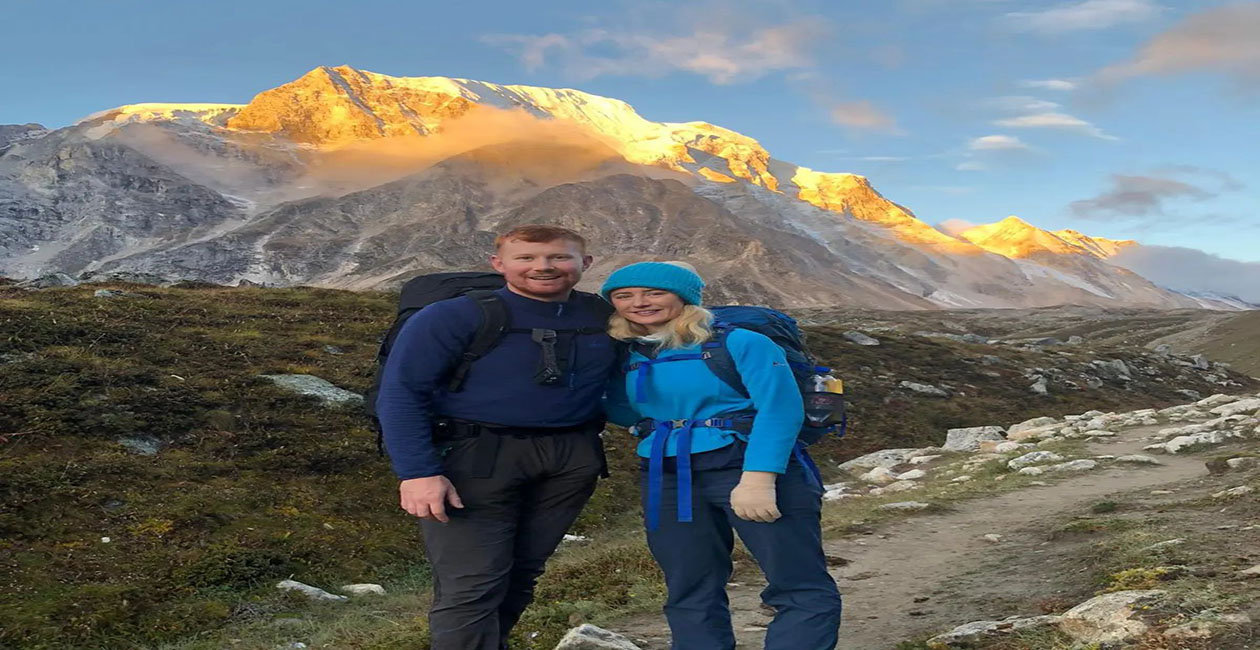
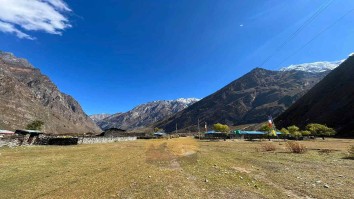
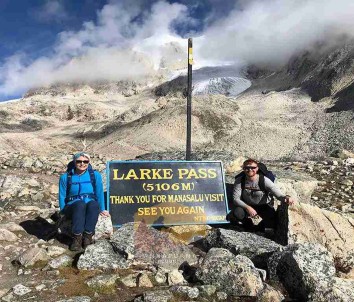
.jpg)
.jpg)
.jpg)
.jpg)
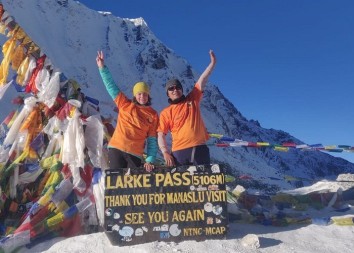
.jpg)
.jpg)

